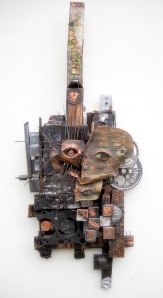
It is generally agreed that you would not fail to know/find a place where an artist works or has been since they leave their mark. Water colours here and acrylics there, a chisel there and a tree stump here that are in time turned into great works of art. There are also finished pieces that have not been sold or are too sentimental to part with that all define the artists’ space that could be like the scents left behind by animals especially predators, to mark their scent on their territory and one wonders whether the artists are as protective as those in the wild.
About two months ago, I visited my friends at Kuona Trust hoping to marvel at them turn what would be considered as worthless material into great works of art. My visit was to spend time with them in their studios to observe, chat and marvel as their creative processes transformed into insightful works of art.
Each piece elicits a different reaction. While some pieces communicate directly, others are subject to numerous interpretations that make them both fascinating and discerning. It is these intrigues that attract me to exhibitions or art studios to see them working or just viewing their past works. As usual I marveled at the pieces as I moved from one studio to another but this time around, something else caught my attention.
The numerous art pieces scattered around the half acre plot ground, where Kuona Trust offices are situated, were captivating. Spread around every available free space, I couldn’t help thinking that probably the artists here had established a large open air exhibition that was both spectacular and like the predators in the wild, a clear marker of their territory.
“This is where art ought to be right from the word go,” I told myself. There is an acute shortage of public art in the remaining open spaces in the city and around the country and the effect of this to our collective psyche and aesthetic, would be a very interesting subject of a research paper. There is no doubt that the political and ruling elite are in class of their own with the way we salivate when we see open space especially in the urban centers.
Any space is quickly converted into a concrete jungle of flats that are in themselves a turn off and an eyesore to say the least. There is nothing aesthetical with the numerous flats that have taken over the city skyline at both the posh and low income ends of the city. Maybe something is often done by the interior designers but outside walls and all other open space are often left bare. There is probably some creative landscaping in some of the flats in the posh suburbs but the drive-ways are not engaging and have no character at all.
At the open air exhibition at Kuona Trust, I marveled at the giant size sculptures by Joseph Bertiers and Gakunju Kaigwa and wondered what kind of temperament they would add to a driveway or any compound in the apartments that are mushrooming in every corner of the leafy suburbs in Nairobi, Mombasa, Kisumu, and others. The buildings have not only transformed these areas into concrete jungles with the Pipeline and Embakasi tenement yards in Nairobi’s eastland clearly demonstrating this, but they have altered the skyline as well.
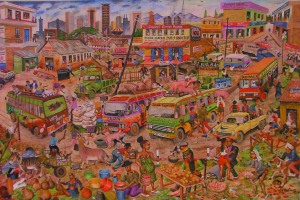
Bertiers has distinguished himself as a gifted artist, whose narratives on canvas are amazing. They are detailed and there is no doubt that he spends time on each piece. If his pieces were viewed with a literary eye, each piece is made of numerous short stories with complete setting, thematic concern, characters, tone and all other elements of a good story.
While his sculptures are probably not as captivating as his paintings, they are equally telling. They are colourful and the contradictions that he packs in every piece are attention-grabbing and no wonder some of his pieces were selected to be used by a consortium of NGOs in the country when carrying out a nationwide civic education program.
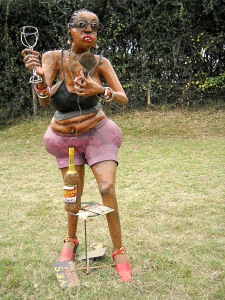
It is this kind of effect that his pieces elicit. Gakunju’s sculptures are often intricate too and near life size. They are often realistic and the ones in the open air exhibition space were both telling and fascinating. They are pieces that could be used in every social—political discourse.
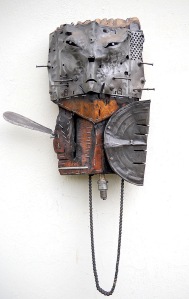
There were other pieces on the walls by Cyrus Kabiru, Dennis Muraguri and Mosoti Kepha that demonstrated just how waste can ben converted into beautiful works of art and how we can creatively use space on the wall. Most of their pieces are made from waste metal and wood. The wood is weather beaten and the patterns on them that are both man made and from the forces of nature, are eye catching. Once got the feeling that he/she was watching some exquisite antics.
There was no doubt that the artists had marked their territory well marked and I will look out for any additions next time I am there.
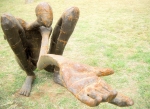


Pingback: The Ambiance of the Artistic Space « kimaniwawanjiru | World of juggling News
Hi Kym, I couldn’t agree with you more. i write about space a lot in my ‘big paper’, the one that is earning me a new title. I also love Mbatia’s work, and i agree some of his sculpture is inelegant, especially his sculptures of women which are quite uncomplimentary, but i am in awe of his imagination, humour and technique. Yes, the Matatu station is a favorite. the details are hilarious and surreal — or should i say super-real since they do reflect much of what Kenyans experience at many matatu stages…. thanx for praising all our friends at Kuona…cyrus, muragori, etc… great things going on at Kuona. Thanx again
This is great work, the matatu piece is so detailed would love to see it live. It reminds me of Tingatinga art with a nuance. Keep it up.
Great commentary, but i trust you know Bertiers is not a Kuona artist. He is utterly independent, although he exhibited at RaMoMA as you know. just wanted to note that because you lovely story on space suggested he was among the Kuona community. He’s a fabulous artist, i agree with you totally!
Thank again for sharing your thoughts on the artistic space.There is always a lot going on in the Kenyan art scene to be shared and I’ am glad you are writing about it,especially visiting where artists work from as hereby referred to as the space ,because most of the time it’s been about exhibitions and we are left wondering if it’s promoting the show or really talking about the artists ,their physical space , philosophy ,spirituality and such ,which I do believe play a great role in the creation of the work at these spaces.Again thanks a lot for sharing.
thanx for visiting artists studios. try and get around more.i agree with mazola, its one thing to write about art shows and another to visit them at their place of work and chat at a more intimate level.i was horrified by some art adminstrator saying an artist shouldn’t be visited in their studio.
the arts diary could be another guide as to where artists are.also ask of interesting studios that are not within radar.
Attractive portion of content. I just stumbled upon your blog and
in accession capital to say that I acquire in fact loved account your weblog posts.
Anyway I will be subscribing on your augment or even I success you get
entry tto persistently rapidly.